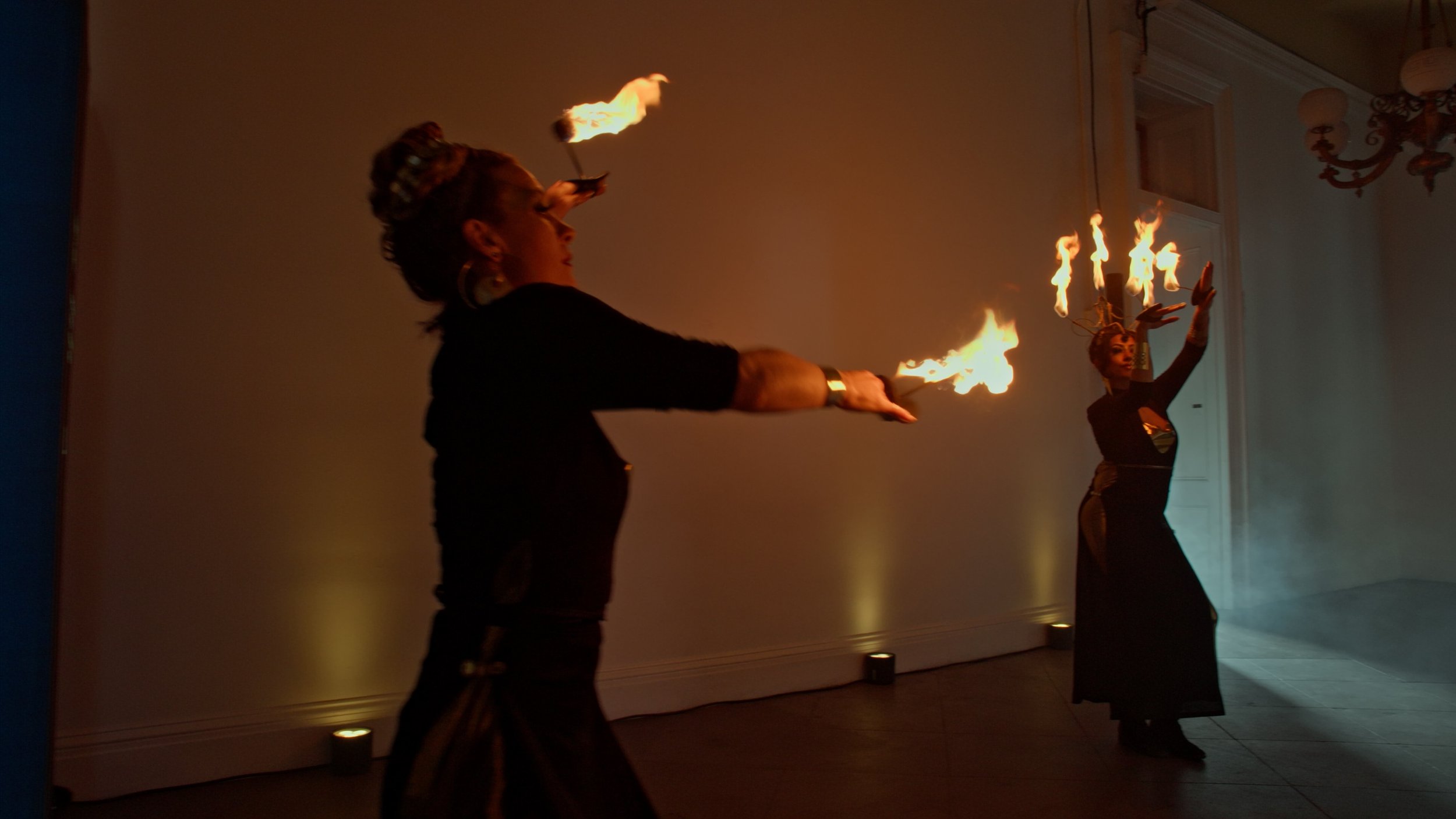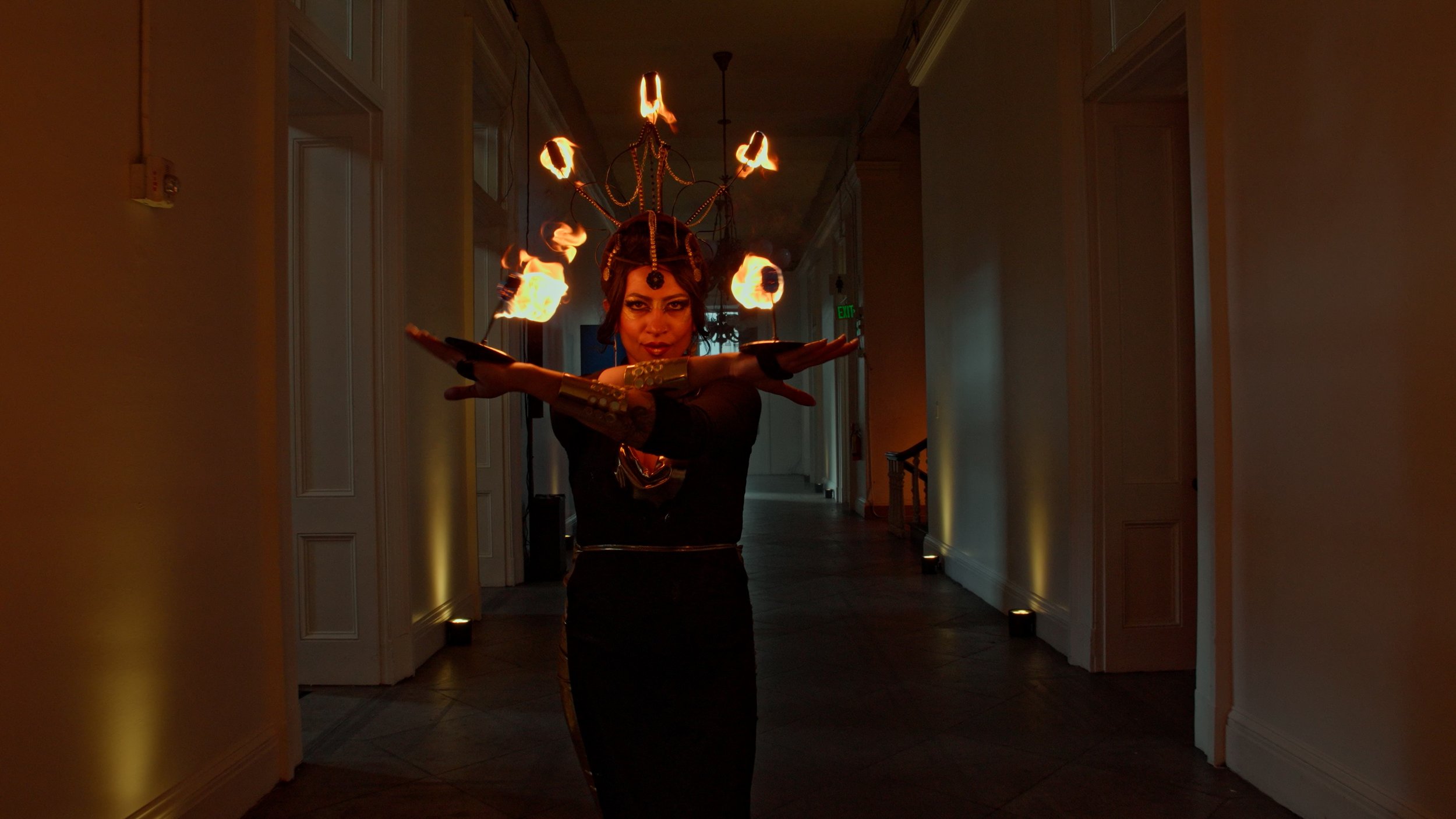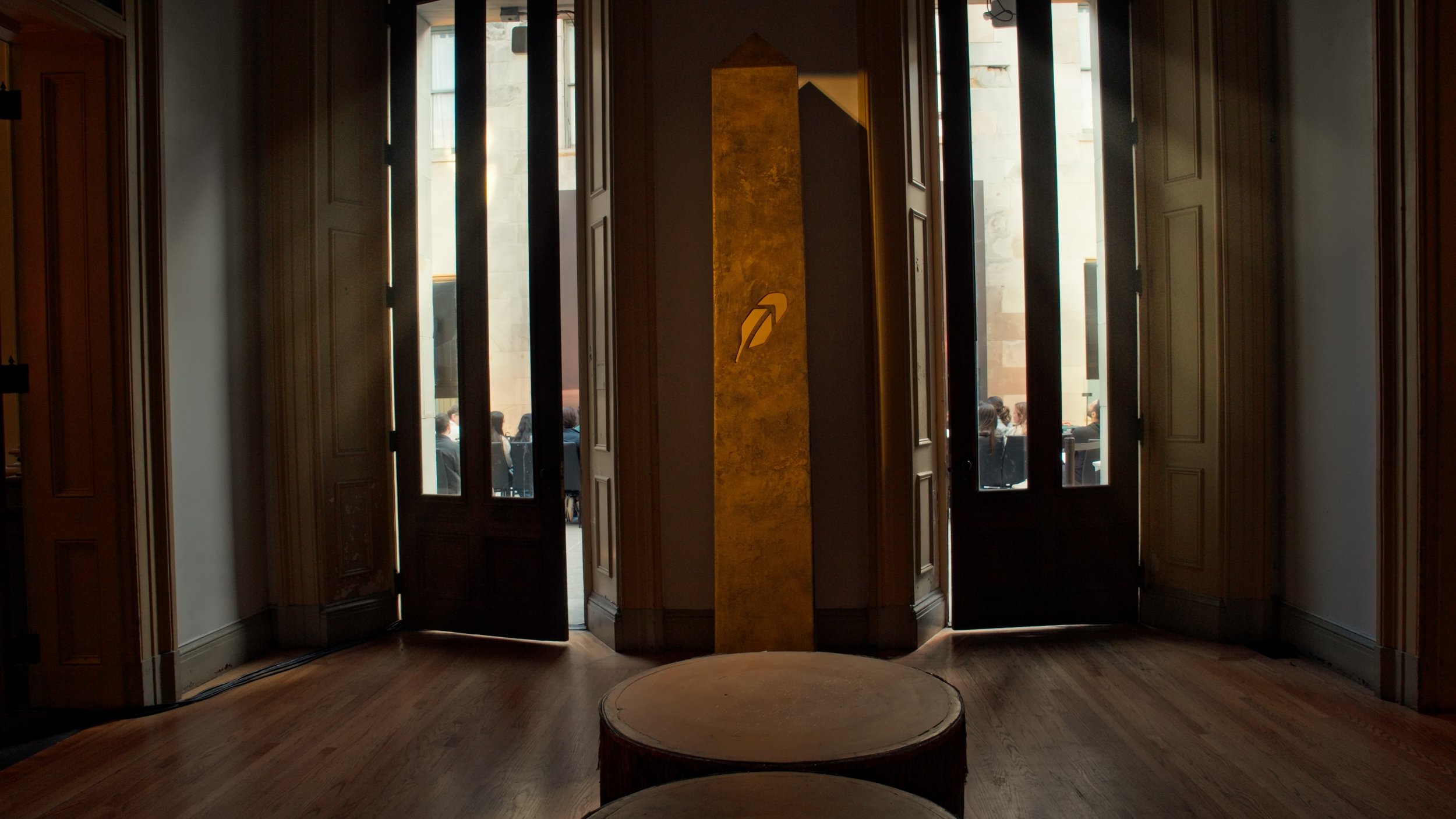Behind the Scenes: A Fintech Company’s Mythic SF Entrance
Setting the Stage: A Myth Reimagined
When a fintech company came to New Revolution Media and Bash Creative, they expressed one goal: to create an epic opening sequence for their newest product launch. Inspired by the theme “The Lost City of Gold,” the concept fused futurism with ancient myth — and the result needed to feel like a discovery, not just a reveal.
Enter the San Francisco Mint. With its massive brick corridors, historic vaults and grand rooms, it already looked like something out of a movie. Our task? Make it grand. To make this happen, Director Pierce Larrick brought me on as Director of Photography and Enrique Camacho as our dedicated Steadicam Operator. Together, we had to find a way to turn this space into a living legend that would be remembered among the many people who would be watching.
The Challenge
There were a lot of moving parts. Literally.
We had:
A CEO entrance that needed to feel effortless but cinematic,
Fire dancers whose timing had to sync perfectly with camera motion,
Lighting and haze designed to transform the room into something dreamlike,
Creating enough light in the underground vaults to give us a usable image,
And one steadicam operator gliding through it all in a single, unbroken shot.
With just one day of rehearsal and blocking, and only two official takes the day before the event with the CEO, it was all about trust, timing, and a tiny bit of magic.
Choreographing the Flow
We approached the entrance like a ritual that began from darkness and led us into the light. We wanted it to feel like a journey through a lost city where each movement felt intentional, almost sacred. The music was our heartbeat.
The fire dancers weren’t just background; they were the architecture of the shot — guiding the eye and building a visual rhythm for the camera to dance with. The CEO’s walk had to feel natural but still carry a weight of importance, like he was a character from a legend.
We spent hours walking and re-walking the path, tuning the tempo with every run. The final sequence was part choreography, part cinematography, part intuition.
Lighting, Haze, and the Obelisk at the Center of It All
As DP, I wanted the lighting to enhance the beautiful features and character that the the Mint already had. Warm amber light, dancing shadows, subtle glow — everything was dialed in to match the golden tone of the theme.
The first thing I had to consider before making any lighting choices was camera. Originally the client was promised a RED Dragon, but I thought a lot about that choice and knew we would be making a mistake if we went that route. See, the client wanted a dark and moody scene and considering the space we were in and the resources we had, we were limited in how we would light this. Two days before rehearsal, I felt haunted by the idea of using the Dragon, not because it’s not a great camera but RED’s just love light and I just didn’t feel like there would be enough output from the fire and the additional fixtures to really give us the image we were looking for. So Enrique and I made a few calls and finally landed on a Sony FX6 so that we could shoot at 12,800 ISO and really be able to get the most information in the vaults (which was already incredibly dark to begin with). We also paired the camera with the Angenieux EZ-2 22-60mm T3.0 FF (PL) that we rented from Lens Rentals. This lens gave us the flexibility to start tight and zoom throughout the sequence with intention.
In the vaults, I set up three Aputure light fixtures which we set the 300X at 3200K, and added 1/2 CTO gels to match the color temp. to both our 300D & 600D. We used those lights to scrape the floor and create a dynamic balance of light and contrast. That way we wouldn’t just be relying on the fire from the dancers to give us enough exposure. The stairway section was where I had to mostly rely on the light coming from a window source. So our amazing 1AC, Kelsey Rivera, had to manage an aputure shift from the vaults to the stairs, to give us an exposure that wasn’t clipping on the window. To emphasize the rays and the beautiful shape the natural light was giving, I had one my PA’s haze the stairs moments before we began rolling. Together we rushed to waft the haze and make it feel dreamy, allowing the light beams from the window to stretch like they were painted in midair.
As we moved to the upstairs hallway, the challenge was finding a way to make the white walls not feel so stale. Luckily, the events team set up small lights along both sides of the hallway that created a nice shape with an amber-like hue. From there I added a 1200D from the first door we see as we come up from the stairs and scraped it along the floor to emulate the sun setting. As we run from the vaults to the stairs, our PA rushed to haze the upstairs hallway and hid in time for us to reach the top of the stairs and begin our walk with our fire dancer. Somehow unintentionally, as we walk down the hallway, another dancer holding a lit torch, gave us a little back light at the entrance of the stairs that just added another dynamic layer to the image. Like Bob Ross, I too call moments like this “happy accidents.”
The haze gave us that dreamy, ancient quality, letting beams of light stretch like they were painted in midair.
And then there was the obelisk.
Lit from within, it stood like a discovery — the “X” at the end of the map. It wasn’t just a logo moment. It was the emotional and visual anchor of the entire entrance, the thing the shot was building toward from the very first frame. Thankfully, the events team felt the same way and aimed a beautiful spolight at the obelisk to really make it pop from the rest of the room.
From the Director’s Chair
This sequence was as much about musicality as it was about visuals. With every moment choreographed to sound, we knew timing was everything. Pierce orchestrated the rhythm behind the lens — syncing together all the elements to create one cohesive flow.
To get a better perspective, I sent Pierce a few questions to help us gain better insight on how he managed to create this choreography in one day:
This sequence was tightly choreographed to music. What was your process for mapping movement — especially the dancers’ and CEO’s cues — to specific beats?
The first priority was ensuring that both the dancers and the steadicam operator were able to seamlessly move from point A to point B within the tight 1:55 second window. Once we had that timing locked in, the next challenge was to fill the frame dynamically, particularly with the use of flames. We were fortunate to have such seasoned performers, whose expertise and feedback were invaluable in enhancing the visual composition and ensuring everything flowed smoothly.
With only one day of rehearsal, how did you manage the timing between performance, camera movement, and music? Were there any surprising breakthroughs or adjustments on-site?
The success of this project was largely due to the incredible understanding and flexibility of our performers and crew. They were able to adapt to our constraints and take ownership of their movements, which was crucial in achieving the desired outcome. Without the amazing team we had, this shoot simply wouldn’t have been possible. I’m truly grateful for each person involved and their dedication to bringing the vision to life.
This was your first time directing a one-take, what advice would you offer other Directors with this kind of challenge?
My advice to other directors would be to always approach the process with kindness and collaboration. At the end of the day, everyone on set is working towards the same goal of creating something beautiful. When you foster a positive, collaborative environment, your team is more motivated, inspired, and ready to deliver their best work. The energy you bring as a director can truly influence the quality of the final product.
The Steadicam Dance
This oner took a lot of brain power to create, so I felt it was incredibly important to hear from our steadicam operator, who is arguable the heartbeat of this entire sequence. I asked Enrique to share what it took to hit every mark, move with intention, and stay locked in with the rhythm of the moment.
Can you walk us through your movement path? What made it technically challenging?
The movement consisted on tracking the dancers backwards, letting them lead me up the stairs, and switching focus between multiple “main subjects or characters”. The challenge really came from having to have everyone hit the marks including myself, the 1AC and the dancers. This take was also incredibly fast, with only about a 1:30 to get from the vaults to the upstairs hallway and into the obelisk room. Each take was another testament to my endurance.
What gear were you using (rig)? And how did that affect your decisions?
We used a Sony FX6 on my steadicam Aero 30 with A30 arm. All together, the rig weighed about 40 lbs, which in the grand scheme of things, is a much lighter rig, but when you’re running with that much weight, your body will feel it regardless.
What were the biggest timing challenges or points of failure you had to watch out for?
One of the biggest timing challenges was the tilt up on the stairs. The pacing of this video was so fast that I felt like there wasn’t a lot of time to focus on a character for too long. I had to turn the corner, tilt up high enough to see the two women on the stairs and then tilt back down to the woman in the window fast enough to match the beat of the music. Everything had to follow timestamps to a tee.
What’s something people wouldn’t expect about what goes into a steadicam shot like this?
Most people outside the business don’t realize how much thought and time it takes to coordinate a one take. It’s a lot of moving parts and everyone has to be in sync in order to make it work. Communication is key for any production, but especially with ones that require so much coordination.
Any moment you’re especially proud of during the take?
I think my best moment is after I reach the top of the stairs and slowly pan to the dancer with the flaming crown. I had to time everything from the dancer leading me up the stairs, land on the new dancer or character, adjust my tilt and horizon and slowly pan and stop for a beat. Everything happened smoothly and as intended which felt really good!
What advice would you give to other operators taking on fast-turnaround, choreographed live shoots like this?
Prioritize your prep time and make sure you communicate with your director and DP every step of the way. It’s important to mention that you shouldn’t be afraid to make suggestions to make the shot work. You’re the expert after all. I had a couple moments where I changed things to make the camera flow more and not feel too chaotic compared to the original concept. This helped my movement and ended up being preferred by the both the director and the client.
Two Takes
When I heard on the day of that the CEO would only have enough time to give us two takes, my heart stopped. Not only did we just spend a whole day rehearsing without him, but we still had a lot of kinks to work out timing wise. But you know what they say, pressure makes diamonds.
Take one was close. A couple of our dancers didn’t quite nail the timing and some missed their cues. So we quickly reassembled, heard some feedback from the client and rushed to get back to our first mark. The overall feedback? The rhythm was good, but the energy needed to swell just a little more.
By take two, everything locked in. The pacing was right. Most of the dancers hit their marks with ease. The haze was sitting just right in the air. And Enrique — well, he glided through it like he'd been rehearsing for weeks.
Suddenly, Pierce yelled “WE GOT IT” and I swear I heard the crew all breathing a sigh of relief.
Now you might be wondering, would I have loved another take and to be honest, I would have LOVED two or three more. But the reality is that most CEO’s don’t have the bandwidth to allot a huge chunk of their time to projects like these. The fact that their creative team even wanted to pitch this idea and bring it to life is a huge undertaking, and I’m glad we made it work with the time we had. But in a perfect world, I would have done at least two more takes to really get as much as we could and find moments of improvement.
Final Thoughts
The “Lost City of Gold” wasn’t just a theme. It was a tone, a tempo, a challenge. This was the kind of shoot that reminds you why we love making images move. It was fast, complex, collaborative and full of the pressure to get it right since it was being broadcast to millions of subscribers. After it aired, someone on the team noticed a couple of tweets that made us feel a little giddy inside after all the effort we went through.
Producer: Felicia Mogavero
Director: Pierce Larrick
Director of Photography: Jennifer Gonzalez
Steadicam Operator: Enrique Camacho
1 AC: Kelsey Rivera
Gaffer: Max Martin
DIT: Jeff Coombs
Editor: Michael Janak
Production Assistant: Aracely Martinez






